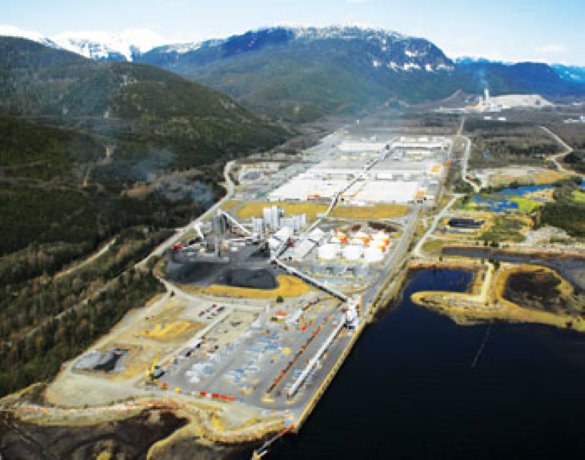Construction has ramped up as Rio Tinto Alcan’s modernizes its aluminum smelter in Kitimat, British Columbia.
Construction has ramped up as Rio Tinto Alcan's modernizes its aluminum smelter in Kitimat, British Columbia.
The US$3.3 billion project, which began in 2011 and is slated for completion in the third quarter of 2014, includes demolishing several buildings on the site of the existing smelter and clearing space for a new plant.
“Climate is certainly a challenge. However, our schedule and work sequence has been taking this into consideration,” said Kitimat Modernization Project (KMP) project director Michel Lamarre.
“We understand that efficiency is not as good in winter and we have sequenced the work in such a way that the bulk of the concrete and steel erection is taking place in during the more clement weather seasons.
“We are making sure that mechanical work that needs to take place in winter will be done under covered areas.”
The project was proceeding at half-speed until late last year. Low aluminum prices and apprehension that another economic downturn might be on the way affected the pace of construction.
But in December 2011, Rio Tinto gave the green light for an additional US$2.7 billion capital investment in order to complete the project.
At the time of the announcement of the additional investment, Bechtel Canada, the engineering, procurement, construction and management (EPCM) contractor, had already completed several segments of the project.
They included the clean-up and demolition of pot lines seven and eight and associated buildings; the relocation of some of the plant’s facilities, so that the existing smelter could continue to operate during the modernization; construction of a three-kilometre underground utilities corridor; completion of an anode pellets storage facility; and building the first phase (440 beds) of the residential village for the construction workers (1,500 beds).
In 2011, there was a work force of 600 on site.
Lamarre said the construction village was completed in April 2012.
Work slated for this year includes completing clean-up, demolition and relocation work by mid-year; pouring the concrete for the anode bake furnace and the pot room; and beginning the erection of structural steel for the main process building. This will be done to put as much of that structure under cover before the beginning of winter.
He said KMP will employ a total of 1,600 workers on site in 2012, but there are some challenges.
Finding enough workers could be tricky.
Four different LNG (liquid natural gas) plants are being planned for B.C.’s coast.
“But this issue is not looking as difficult as it was a year ago,” Lamarre said.
“At that time, it appeared there would be many other industrial facilities in construction in the Kitimat region. But, now it looks like the potential LNG projects are to take place at a later stage, so we aren’t facing any serious competition for labour.”
The Kitimat Modernization Employer Association has a project labor agreement with the Coalition of British Columbia Building Trade Unions, which was formed in 2008.
It is made up of 15 different internationally-affiliated unions.
The agreement has a no-strike and no-lock-out clause and a commitment to hire local and aboriginal workers.
“The contractors confirm their craft requirements with the union business agents,” Lamarre said.
“The unions then communicate the project conditions and assign the interested craft available from the various union halls in B.C. and other parts of Canada.”
Mark Olsen, president of the coalition, said the first phase of the modernization project, which is expected to be completed by the end of 2012, requires mostly workers in the civil trades – laborers, operating engineers, carpenters, cement masons and sheet metal workers.
The second phase, which is slated to begin at the end of 2012 and finish in 2014, will require workers in the mechanical and electrical trades – pipefitters, boiler makers, electricians, millwrights and bricklayers – in addition to the civil trades.
Olsen said more than 50 per cent of the workers are from Kitimat and Terrace.
Most of the remainder are from other regions of B.C. and a few are from other parts of Canada.
Olsen said the project has yet to run into labor shortages, but there is one exception.
High-reach shear operators, who are specialists in demolition, have been in short supply.
Some workers are being trained in new areas to perform work in later stages of the project.
“People are being trained in concrete pouring, cement finishing and scaffold erection, either by their unions or by colleges in the region,” Olsen said.











Recent Comments
comments for this post are closed